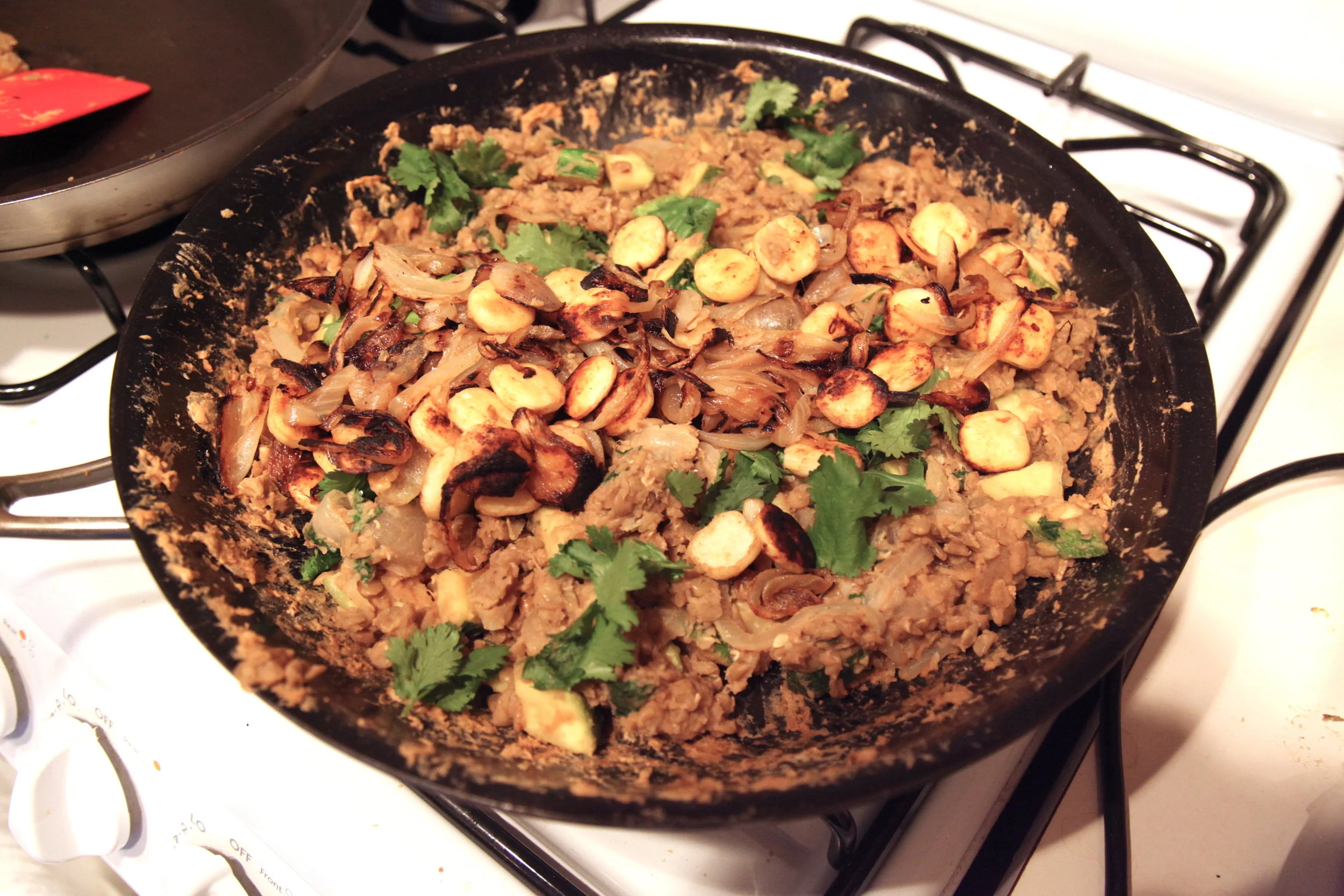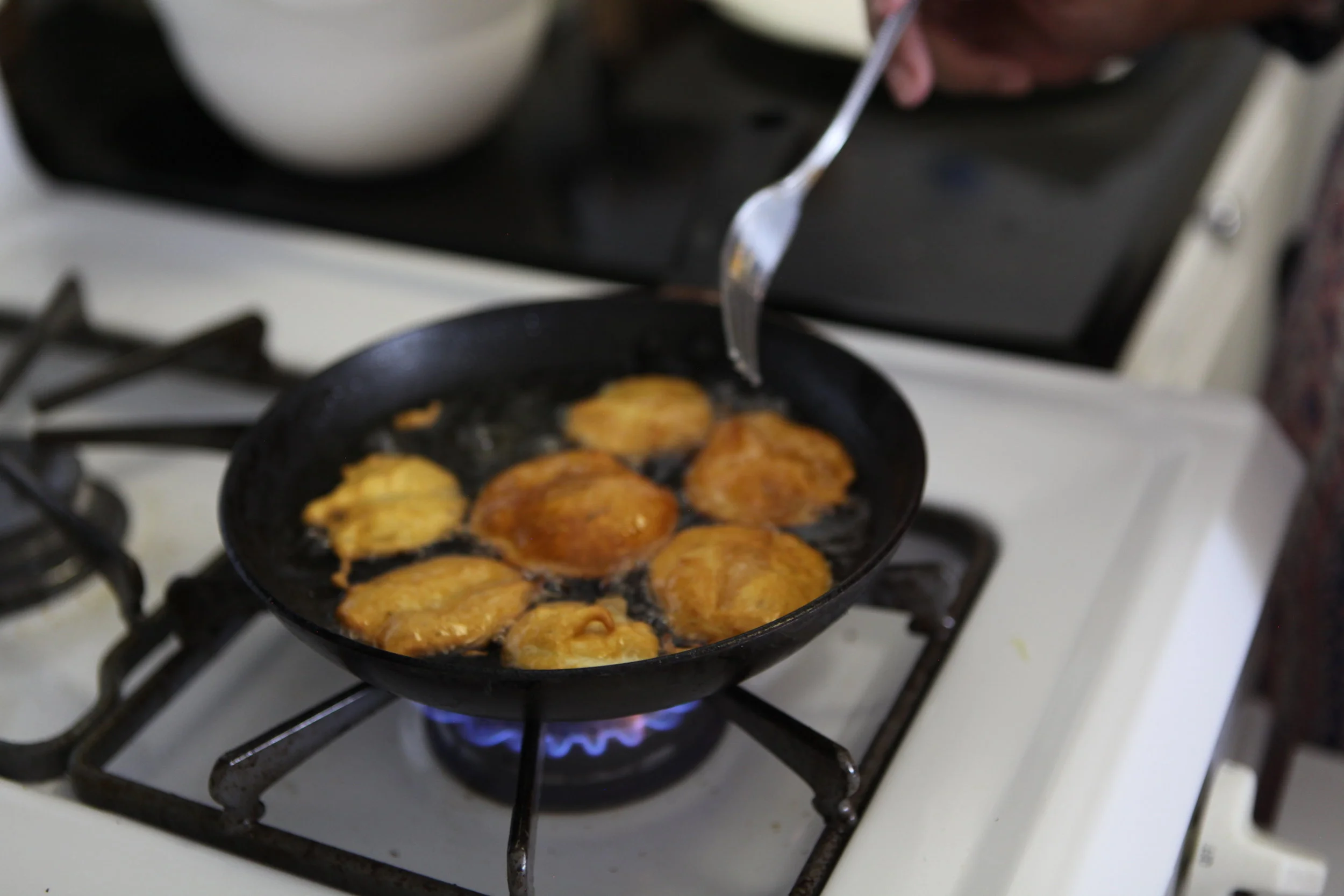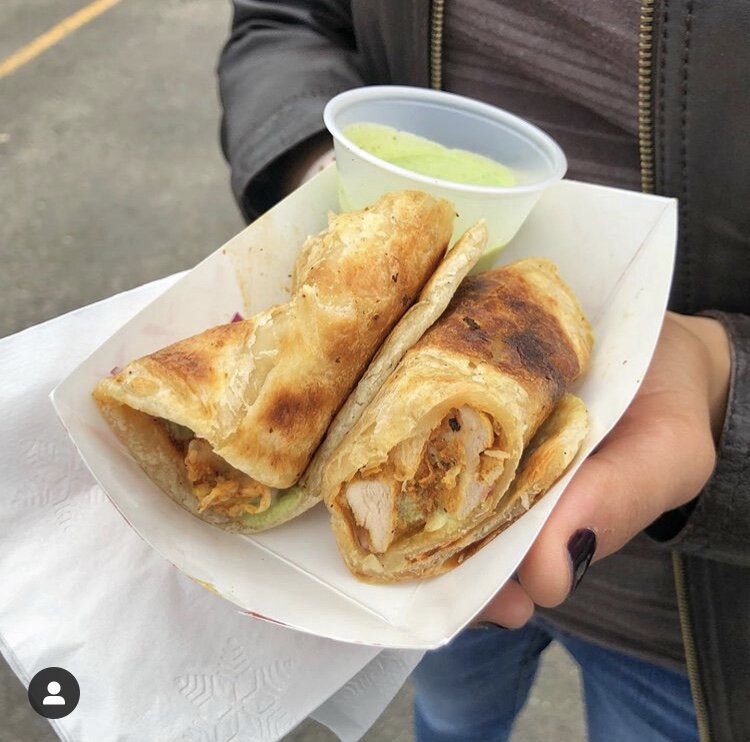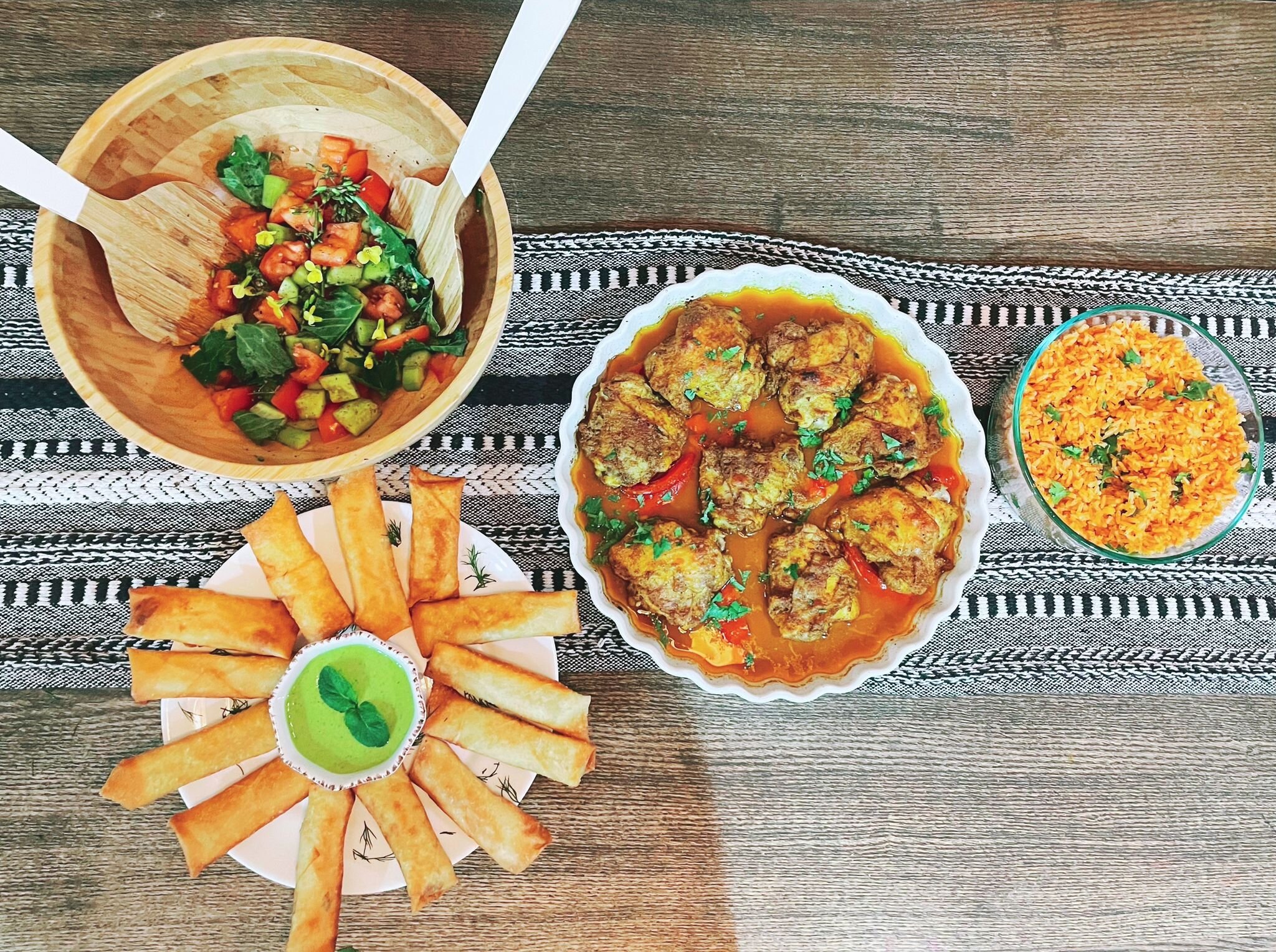Samosas (Pakistan)

Rabia’s memories of Ramadan growing up was of suhoor meals, because it was the only time of the year when her mom would make paratha [a traditional flat bread] at home. “Every single morning, I woke up to the smell of ghee frying the paratha, and we always had it with a very light curry and yoghurt, and that’s my indelible memory of growing up with my family and fasting”.
Perhaps a sign of modern times, it’s been harder to instill such ritual with her own family. “My mom would just put something on the table and we ate it…but now my daughter wants Greek yoghurt and fruit, my husband wants something that nobody else wants…everybody is so particular about what they want, it’s just too complicated!”.
Though she was born in Pakistan, Rabia’s family emigrated to the US when she was a baby, and she and her siblings spent some time of their childhood in small agricultural towns as her father worked as a vet, before the family eventually settled in the DC area.
“My parents fought assimilation every step of the way!…but it wasn’t like they were harsh. At school, we took part in Christmas pageants and concerts, and things like that…but they always wanted to keep our cultural identity. We fasted together, we prayed together and spent a lot of time watching Bollywood together and eating a lot of Pakistani food together!”
Rabia still makes a ritual of eating meals with her husband and daughter, though what they eat changed after she turned 35 years old. The family used to have pakoras and samosas every night. “We would end up gaining weight every Ramadan. Our bodies couldn’t take it.” Instead of focusing on food, the family has added a new Ramadan ritual - “We decorate the house before Ramadan with string lights and little stars and moons that we hang on our banisters. That wasn’t really a thing growing up, but it’s become a lovely part of actually celebrating the season”.
“The meaning of Ramadan has really changed for me in the past 10-15 years, or so. I'm in a place now where like, every year, I look forward to Ramadan so much, and it goes by so fast, and I am so upset when it's over! Growing up, it was like a burden, it felt like something we had to do versus something we wanted to do. But to me, now, Ramadan is just about a time for recalibrating, reflect on what's really important.
It's been interesting because this is our second Ramadan during pandemic. And in a very big way the pandemic has actually helped us do Ramadan right. Because Ramadan, often in our communities turns into a party every night, and it's not supposed to be like that. Of course, community, family, and friends are important. But Ramadan is really about withdrawing yourself from a lot of material things and having more time for contemplation, having more time in your home, consuming less of all kinds of things, not just food and drink, but consuming less of the world. And so the pandemic has helped us do that.
I remember last Ramadan, a lot of people were upset that they couldn't do the iftar parties but I kind of loved it. I love just being home. In normal times, a month before Ramadan even begins, the invitations start coming in. And then you're like, okay, so these are the 10 families that invited me. So I now have to reciprocate for those 10. And you spend your whole month - especially for women - you know, who are take on the bulk of it- just cooking, cooking, cooking. And that's not what it should be about.
I want to be able to spend an hour listening to maybe a great lecture or reading Quran or scripture or spending time with my prayer beads or just meditating in my garden. So I just think it's about withdrawing from from the world and, and refocusing on what's actually important”.
I asked Rabia about a quote of hers that I find beautiful: “The greatest gift of Islam to my flesh is wudu [ablution] and sujood [prostration]. Wings and a cocoon.” She admits she wasn’t always so excited about the fresh water on her face early in the morning. “But now it just brings me so much serenity, it just puts you in a different state of mind and the more thoughtfulness you do it with, it just really becomes a meditation. I love it. And I love sujood for the same reason because I think it’s such a gift. I know people in yoga do it now. Right? So for us, you know, whatever benefit people find in putting their forehead to the ground in yoga, like we, when we do it dozens of times a day through the repeated prostrations, I feel like we're not just getting the physical benefit of whatever that does to your body, making your blood circulate in a certain way, but also, there's just something like, I feel a closeness with God in that position that I don't in any other”.
Rabia, an attorney and advocate, is putting the values of her faith at work through her dedication to social justice. “My mother always, always, drilled into us that it is your religious obligation to do something to change the world. She would say “do you think God gave you an education, money and skills and expect nothing in return? What service to humanity will you provide?””
Her current focus is on helping wrongfully imprisoned people get exonerated. She is most notably known for tirelessly advocating for Adnan Syed whose story came to be widely known through the Serial podcast. She herself is the co-producer and co-host of three podcasts, and just submitted her 2nd book to her publisher, Fatty Fatty Boom Boom, a memoir on food, fat, and family and is already working on her 3rd one.
She shares here her samosa recipe, and check out her boba Rooh Afza drink here.
While they don’t eat them every night like they used to, making the samosas remains a Ramadan ritual. At the onset of the month, Rabia will make a batch of 200 beef or chicken samosas, which are her family’s favorite. “I freeze them, but I don’t fry them every day - we only get them a couple times a week or if we have guests over”.
“Samosas are the one thing I make ahead of time because I haven’t been able to find anything commercially that I think is as good as the homemade ones…If I did, I’d probably get them ready-made!”.
The traditional samosas are usually filled with potatoes, but “when you get keema somosas - filled with ground chicken or ground beed, it’s kind of special. I remember early on, not being able to figure out like what to wrap them in. I didn't like the egg roll wrappers. There weren’t a lot of options 15 years ago in the in the halal shops for different kinds of samosa wrappers. I couldn't use pastry, that didn't work. And I couldn't make my own dough, it was just too much effort to make the dough, make the rounds, etc. And then I ate an empanada somewhere. And I was like, what is this?! It was the perfect flaky crust, that could be perfect for samosa and then I found ready made empanada wrappers in the store. I was like, let me just give this a shot and they were a hit, they were perfect. And they made the most perfect size samosa. I've been making them with that, ever since”.
Ingredients
Empanada wrappers
Filling as per your preference (meat, traditional, “Tex-Mex”)
Directions
Make your filling - you can use minced beef or chicken, which is what Rabia uses. She fries the meat in bait of oil with generous quantities of minced garlic, ginger and cumin seeds. Add salt to taste. Once it cools, she adds chopped green chillies or jalapeños, cilantro, and onion.
For a vegetarian option, you can make it with the traditional boiled potatoes, roughly chopped and add frozen peas, salt and cumin, and again fresh chopped chillies, cilantro and onion.
or there is Tex-Mex style, stuffed with a mixture of boiled potatoes, corn, jalapeño and cheese.
Let the filling cool.
The secret to Rabia’s samosas is the frozen empanada wrappers. Thaw them and cut them in half.
Fold to join the straight edged side together to form a cone. Fill the wrappers. Use a little water to help seal the edges and press with a fork.
Put them in a tray as you’re making them, but don’t overlap them or let them touch. Lay them in a single layer, cover it with wax paper and make another layer.
Fry them fresh or freeze them. You can just pop the entire tray with a few layers of samosas into the freezer. Once they’re frozen, transfer them to a freezer bag to use for the rest of the month. Don’t store them in the fridge, not even overnight or the dough will dry out.
Fry them directly out of the freezer in at least 3-4 inches of medium hot oil. Rabia fries for about 3-4 minutes per batch, turning them over so they get brown all over.
Enjoy!









